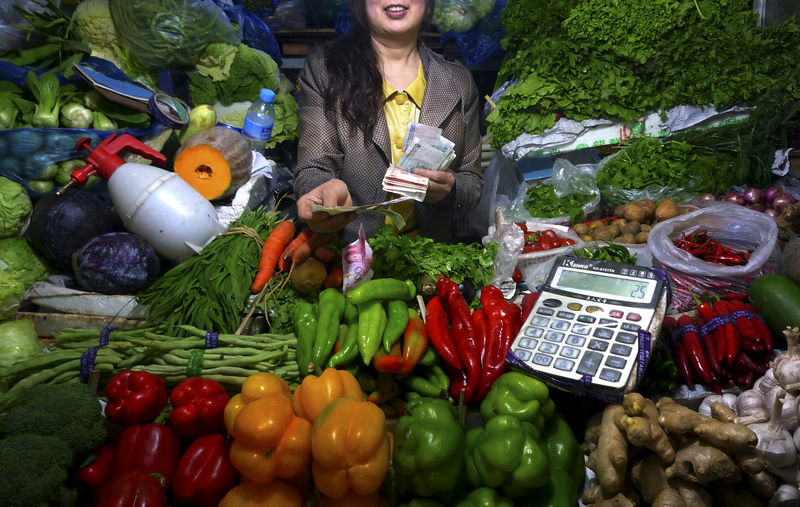By Elias Glenn
BEIJING (Reuters) - China's April producer price inflation cooled more than expected in a sign manufacturing activity may be losing momentum along with other sectors of the economy as domestic demand remains muted and the government cracks down on financial risks.
Prices for raw materials fell in April from the previous month, pressured by fears that domestic demand will not be strong enough to absorb surging factory output that rose the most in more than two years in March.
A renaissance in China's steel industry has been a major driver of the world's second-largest economy in recent quarters, helping generate the strongest profit growth in years and adding to a reflationary pulse across the global manufacturing sector.
But China's reflation cycle in producer prices has probably peaked, and will trend down further, which could drag on China's economic growth in the second half of the year, said Betty Wang, senior China economist for ANZ in Hong Kong.
"The recovery momentum in the economy that emerged in the second half of last year was mainly driven by producer price inflation rather than any changes from a fundamental perspective," Wang said.
The soft April inflation data, combined with slightly slower growth in manufacturing activity, reinforces analysts' views that China's economic expansion remains solid but is starting to moderate after a surprisingly strong start to the year.
First-quarter economic growth came in at a faster-than-expected 6.9 percent, which could give the economy enough of a tailwind to hit Beijing's full-year target even if growth starts to fade in coming quarters as many analysts expect.
With growth comfortably above this year's target of around 6.5 percent, Chinese policymakers have shifted focus to reining in financial risks, which ANZ's Wang said will not change based on trends in producer and consumer prices.
"Deleveraging remains the policy focus, regardless of the PPI or CPI trend. We don't think PPI or CPI will have any significant impact on the current policy direction," said Wang.
The producer price index (PPI) in April rose 6.4 percent from a year earlier, the National Bureau of Statistics said on Wednesday - cooling for the second month in a row. It was slower than economists' expectations for a 6.9 percent rise and easing further from the previous month's gain of 7.6 percent.
Analysts said the rally in producer prices may have peaked as a torrid rally in China's commodities markets showed signs of correcting. Iron ore and steel hit multi-month lows on China's future markets in April amid concern over rising inventories.
Capital Economics said in a report that producer prices were set to fall again in May given that the rout in industrial commodity prices had deepened.
"Further ahead, producer price inflation should continue to wane as policy tightening weighs on economic activity...hopes for a sustained reflation in China are fading."
On a month-on-month basis, producer prices fell 0.4 percent in April, the first drop since June, led by declines in iron and steel smelting and processing.
Iron and steel processing prices fell 3.1 percent month-on-month in April, compared with a 2.3 percent rise in March, while oil and natural gas prices also fell after rising the previous months.
In March, China's PPI cooled for the first time in seven months as commodities prices tumbled, pressured by fears that Chinese steel production is outweighing demand and threatening a glut of the metal later this year.
Factory gate prices had only turned positive on a year-on-year basis last September, after falling for nearly five years, leaving many industrial firms saddled with idle capacity and less cash flow to service their debts.
The consumer price index (CPI) in April rose 1.2 percent from a year earlier, the statistics bureau said, up from a 0.9 percent rise in March and slightly above analysts' forecasts.
Food prices, the biggest component of the consumer price index (CPI), fell 3.5 percent.
Core inflation inched up to 2.1 percent, with costs for health care rising 5.7 percent.
Analysts polled by Reuters had predicted April consumer price inflation would edge up to 1.1 percent but remain well within the central bank's comfort zone, giving it room to continue with a gradual pace of monetary policy tightening without hurting economic growth.
China's annual inflation is to average 2.1 percent in 2017 and 2.3 percent in 2018, according to a Reuters poll of over 75 economists.
Beijing is targeting consumer inflation of 3 percent this year, unchanged from 2016.
Chinese President Xi Jinping called last month for increased efforts to ward off systemic risks to help maintain financial security, the official Xinhua news agency reported.

For graphic on China economic snapshot click - http://tmsnrt.rs/2lQ48De